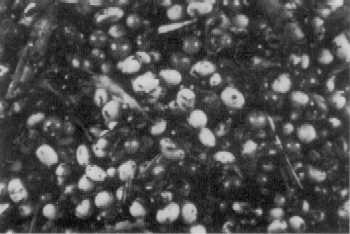Annual nightshades
Learn how to identify nightshade and control options.
ISSN 1198-712X, Published August 1994
Introduction
Annual and perennial species of nightshade are found in Ontario. Annual nightshades have become a major weed problem in soybeans, field beans, potatoes, tomatoes, peas and alfalfa. Nightshades are "secondary" weeds which typically become established when more competitive weeds have been controlled. Infestations can reduce crop yield and quality, and increase harvesting costs. Harvesting of soybeans and field beans can be severely hampered by populations of annual nightshades. Nightshade plants are not affected by light frosts and do not dry out quickly during early fall. Stems, leaves, and berries can plug combine rotors and screens. Sticky juice from the berries mixes with soil, chaff and other weed seeds to form a discoloured coating on the beans and parts of the combine. Beans stained with nightshade berry juice are difficult, if not impossible, to clean (Figures 1 and 2). Moisture provided by nightshade berries may also encourage the incidence of mold and other postharvest storage problems.
Annual nightshades are able to germinate, flower and produce mature seeds within a six-week period, and may continue to produce seeds for several months. Prolific seed production of nightshade plants means that a few plants one year can multiply into a large infestation the next year.
Description
The most common species of annual nightshade in Ontario is eastern black nightshade (Solanum pytcanthum Dun.), although black nightshade (S. nigrum L.) and hairy nightshade (S. sarachoides Sendt.) also occur. They are commonly found in cultivated fields, gardens, waste places, fencerows, edges of pastures and open dry woods.
Nightshade seeds may be introduced into a previously clean field as contaminants in crop seed, by farm machinery or possibly by birds. Seeds may pass through the digestive tract of birds and animals unharmed. Seeds of annual nightshades generally germinate in late spring, but seedlings can continue to emerge throughout the summer months with adequate moisture (Figure 3).
These tiny plants resemble pigweed seedlings except that the leaves are often dark green with a purplish lower surface and toothed margins. Stems of annual nightshades are erect, slender, and often branched. The leaves are alternate (1 per node) and ovate or diamond-shaped. Flowers are small (9–15 mm in diameter), white (often tinted with purple) and resemble potato flowers. They occur in clusters of 2 to 5 on a short stalk attached to the stem. The fruits are small (5–9 mm), green at first but turning black (sometimes brownish green) at maturity, and contain many tiny seeds (Figure 4).
Weed control
Annual nightshades can be effectively controlled by cultivation or the proper selection and use of herbicides. Cultivation can effectively eliminate plants which escape herbicide treatments and thus prevent seed production. Control ratings with recommended herbicide treatments for soybeans are presented in Table 1. Preplant incorporated treatments containing clomazone (Merit), metolachlor (Dual), dimethenamid (Frontier), or imazethapyr (Pursuit) provide good nightshade control. Preemergence treatments with metolachlor, dimethenamid, and imazethapyr provide excellent control. Imazethapyr is also effective when applied postemergence and as a preplant no-till treatment. Emerged annual nightshades may be controlled by bentazon and acifluorfen; however, no residual activity is provided by these herbicides and later emerging seedlings will not be controlled.
There are many herbicides available for nightshade control in field corn. Treatments containing dimethenamid (Frontier), metolachlor (Dual), atrazine, cyanazine (Bladex), dicamba (Banvel), bromoxynil (Pardner), or 2,4-D + dicamba + mecoprop (Kil-mor) provide excellent control. It should be noted that 2,4-D alone is not effective on annual nightshades. For information concerning combinations of these herbicides, rates of application, and specific cautions, consult the latest edition of OMAFRA Publication 75, Guide to Weed Control.
| Herbicide | Control rating |
|---|---|
| Clomazone | Good |
| Dimethenamid | Good |
| Ethalfluralin | Fair |
| Imazethapyr | Good |
| Metolachlor | Good |
| Trifluralin | Poor |
| Herbicide | Control rating |
|---|---|
| Dimethenamid | Excellent |
| Imazethapyr | Excellent |
| Linuron | Good |
| Metobromuron | Good |
| Metolachlor | Excellent |
| Metribuzin | Poor |
| Monolinuron | Good |
| Herbicide | Control rating |
|---|---|
| Acifluorfen | Good |
| Bentazon | Fair |
| Imazethapyr | Excellent |
| Thifensulfuron-methyl | Poor |



